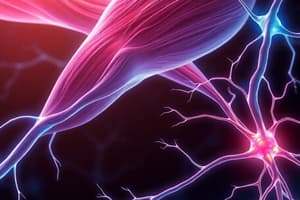Podcast
Questions and Answers
What is the main purpose of the ATP attachment to the myosin head during the sliding filament mechanism?
What is the main purpose of the ATP attachment to the myosin head during the sliding filament mechanism?
- To cause the myosin head to detach from actin and pivot back to its original position (correct)
- To provide the energy for the power stroke of the myosin head
- To activate the myosin ATPase enzyme and prepare for the next contraction cycle
- To initiate the release of calcium from the sarcoplasmic reticulum
If the sarcoplasmic reticulum is unable to actively pump calcium ions back into its lumen, what would be the effect on the sliding filament mechanism?
If the sarcoplasmic reticulum is unable to actively pump calcium ions back into its lumen, what would be the effect on the sliding filament mechanism?
- The myosin ATPase would be unable to be activated, preventing cross-bridge cycling
- The sarcomeres would be unable to shorten, preventing muscle contraction
- The myosin heads would remain permanently attached to actin, causing rigor mortis (correct)
- The tropomyosin would be unable to move back to cover the myosin binding sites on actin
Which of the following is the primary role of ATP in the sliding filament mechanism of muscle contraction?
Which of the following is the primary role of ATP in the sliding filament mechanism of muscle contraction?
- Causing the release of calcium from the sarcoplasmic reticulum
- Providing the energy for the power stroke of the myosin head (correct)
- Facilitating the movement of the thin and thick filaments past each other
- Activating the myosin ATPase enzyme to initiate cross-bridge cycling
What is the main function of tropomyosin in the sliding filament mechanism of muscle contraction?
What is the main function of tropomyosin in the sliding filament mechanism of muscle contraction?
How does the presence of extracellular calcium ions affect the sliding filament mechanism of muscle contraction?
How does the presence of extracellular calcium ions affect the sliding filament mechanism of muscle contraction?
Which of the following substances or conditions would result in flaccid paralysis, and how does it affect the sliding filament mechanism?
Which of the following substances or conditions would result in flaccid paralysis, and how does it affect the sliding filament mechanism?
How does the frequency of stimulation affect muscle tension during the sliding filament mechanism?
How does the frequency of stimulation affect muscle tension during the sliding filament mechanism?
What is the primary role of the power stroke in the sliding filament mechanism of muscle contraction?
What is the primary role of the power stroke in the sliding filament mechanism of muscle contraction?
How does the sliding filament mechanism contribute to the shortening of a muscle fiber during contraction?
How does the sliding filament mechanism contribute to the shortening of a muscle fiber during contraction?
Flashcards are hidden until you start studying
Study Notes
Muscle Contraction Overview
- Skeletal muscle contraction is initiated by significant amounts of acetylcholine (ACh) released at the neuromuscular junction.
- A high density of receptors at the motor end plate ensures efficient signal transmission.
- To inhibit skeletal muscle contraction, it is necessary to inhibit the motor neuron.
Molecular Basis of Skeletal Muscle Contraction
- In a relaxed muscle state, tropomyosin obstructs myosin binding sites on actin filaments.
- Myosin head activation occurs through the hydrolysis of ATP into ADP and inorganic phosphate (Pi), with energy stored in the activated myosin head.
Steps in Muscle Fiber Excitation and Contraction
-
Excitation of Muscle Fiber
- The sarcolemma undergoes depolarization, leading to an end-plate potential (EPP) followed by an action potential (AP).
- The action potential propagates down T-tubules, reaching deep within the muscle fiber.
-
Excitation-Contraction Coupling
- The action potential in T-tubules stimulates the release of calcium ions (Ca²⁺) from the sarcoplasmic reticulum (SR) via mechanically gated channels.
- Released Ca²⁺ binds to troponin, triggering conformational changes that move the troponin-tropomyosin complex and expose the myosin binding sites on actin.
-
Contraction (Sliding Filament Mechanism)
- Activated myosin heads attach to exposed binding sites on actin, forming cross-bridges.
- The energy stored in the myosin head is released, causing the head to pivot (power stroke) and pull actin filaments towards the center of the sarcomere (M line).
Muscle Twitch and Contraction Phases
- A muscle twitch consists of:
- One stimulus producing one action potential, lasting 1-2 milliseconds.
- A latent period (~2 milliseconds) where excitation and coupling processes occur.
- A contraction period (10-100 milliseconds) characterized by increased tension and sliding filament activity as Ca²⁺ is released from the SR.
- As relaxation begins, the SR rapidly reabsorbs Ca²⁺ through the SR Ca²⁺-ATPase, limiting maximum tension generation.
Wave Summation and Tetanus
- A second stimulus before complete relaxation from a previous contraction results in additional Ca²⁺ release, leading to a stronger second contraction (wave summation).
- Rapid sequences of stimuli without complete relaxation yield progressively higher tension, classified as incomplete tetanus.
- Sustained contractions without relaxation, known as complete tetanus, can generate up to 3-4 times the tension of a twitch, with all troponin saturated with Ca²⁺, leading to enhanced contractile efficiency due to increased temperature and ATP availability.
Fibre Length Impact
- Optimal muscle fiber length at rest is crucial for maximizing the number of cross-bridges formed upon stimulation.
Studying That Suits You
Use AI to generate personalized quizzes and flashcards to suit your learning preferences.




